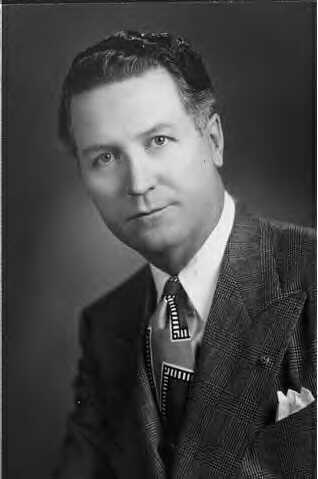Rex Howell
Rex Howell was born in 1907 in Norton, Kansas. Early in his life, his family moved to Longmont, Colorado and it was there he became interested in ‘wireless.” He learned Morse Code at 10 and was building his own radio transmission equipment from Mason Jars, batteries and oatmeal canister coils. By 1921 this self taught radio pioneer had his first license and had broadcast a signal heard in Boulder, twenty miles away. In high school, he worked for KFEL as an announcer, and janitor.
In 1926, he put KFXJ on the air in Edgewater with 15 watts. In 1927 he increased power to 50 watts. In 1930, CBS gave their affiliation to KLZ. Now with power up to 100 watts, he moved to the western slope at the urging of the Grand Junction Chamber of Commerce.
During the depression, Howell went to Dr. O.M. Morrison and said he needed a lot of money – $750.00. Dr. Morrison wrote him a check for $1,000, an investment that paid off for the community Rex Howell chose to serve.
1942. KFXJ was authorized to build a new 1,000 watt station. On May 4th, 1954, he provided the Grand Valley with KREX-TV, its first TV station. It was followed by KREY in Montrose and KREZ in Durango, completing the XYZ Televison Network.
WORX, a Howell ham radio station was used for Colorado families to talk to their loved ones overseas during World War II and the Vietnam War.
In broadcasting, he was the first president of the Colorado Broadcasters Association, Chairman of the National Association of Broadcasters, a director of BMI land on the Board of Advisors for CBS, the network that passed him over in 1930. Not bad for a guy with a high school diploma.
Today, one of the most coveted awards from the Colorado Broadcasters Association is the Rex Howell Award. A tribute to a real broadcast pioneer who has had a profound impact on the industry.

Pete Smythe
Pete is a man of the West, born in Glenrock Wyoming in 1911. A clue of what was to come, Pete’s folks ran a General Store. He was on the State Championship basketball team and had taken up music, playing saxophone and clarinet. Just out of High School, he formed the Whiz Bank Four dance band that traveled in Wyoming, Montana and Utah. By 1930, the Pete Smythe Orchestra was a fixture on campus, as he studied Business Administration.
Off to Hollywood 1935 and 36, playing in the Orville Knapp Orchestra at the Beverly Willshire Hotel. Then back to Denver where he married Peggy Simpson and until 1941, his orchestra worked the Cosmopolitan Hotel, the Brown Palace, the Broadmoor and Eddie Ott’s.
In 1941, it was “Meet the Boys in the Band” on KMYR. By 1945, he had joined KLZ as a salesman, then Program Director. Then Hollywood again, where he wrote for many top network radio shows including Stars Over Hollywood, My Favorite Story with Ronald Coleman, The Bing Crosby Show, Eddie Bracken Show, Edgar Bergen and others.
He returned to Denver in 1948. He started his General Store show on KTLN and by 1951 it was Smythe’s General Store on KOA. He created an imaginary town, East Tincup, got himself named Mayor and had regular visitors for listeners and eventually viewers. To his listeners and viewers, East Tincup became a big part of their broadcast life.
He semi-retired in 1969 to travel, write play golf, ride horses and goof off. This meant being active in the community. His public service included being a member of the Cattlemen’s Association, Chairman of the Denver Boy’s Club and on the board of the State Historical Foundation. He remained sought after for voice-overs and on-camera work long after his retirement from daily broadcasting.
He passed away in 2000 at the age of 88.
Lorem ipsum dolor sit amet, consectetur adipiscing elit. Ut elit tellus, luctus nec ullamcorper mattis, pulvinar dapibus leo.

Hugh B. Terry
Hugh B. Terry has been described as a dedicated journalist and a savvy businessman. That’s the combination that made his history as a radio and TV station manager so remarkable.
He was born in Alexandria, Nebraska in 1908. In 1930, he graduated form the U. of Missouri with a BA . of Journalism. His start was in St. Louis at an ad agency as a copy writer. In 1932, he went to work of Oklahoma Publishing CO. as a salesman for WKY in Oklahoma City. In 1936, he was named manager of KVOR in Colorado Springs.
When he arrived at KLZ radio in 1941, Hugh Terry assembled a bright young staff that filled the station’s offices with awards. He donated his own time to numerous civic and charitable organizations.
One of his lasting accomplishments was to write a series of editorials in 1955 that led to a Colorado Supreme Court ruling allowing cameras and tape recorders into courtrooms. KLZ cameras televised the trial of John Gilbert Graham, who was convicted of bombing United Airlines Flight 629 over Longmont. It confirms a statement by Vincent Wasilewski, a former president of the NAB, that “Terry is a leader who has always argued vehemently for broadcasting’s rights to editorialize.”
Among an impressive list of activities, he was a director of the National Association of Broadcasters. As a sparkplug on the NAB and BMB directorates, a member of the NAB Industry-Wide Code Observance Committee and the sole American broadcaster invited to UNESCO Program Commission Conference, Terry played a unique role in industry activity.
Denver television viewers rewarded his courage and creativity. Channel 7, owned by Time Inc. for most of his tenure, rode high in the ratings–No. 1 for 20 years, through his retirement in 1974.
He had a sense that few other managers had at the time. Many television managers–even today–come up through the business side of broadcasting. Terry was a journalist; he understood journalism and journalistic ethics. He was often referred to as “Mr. Broadcasting,” but the title embarrassed him.
Hugh Berkley Terry died November 28, 1987, at the age of 78.

